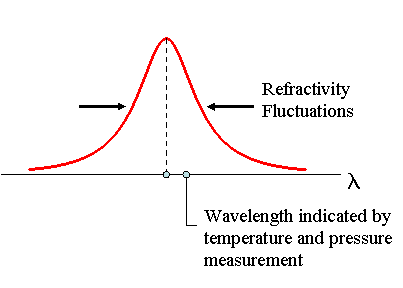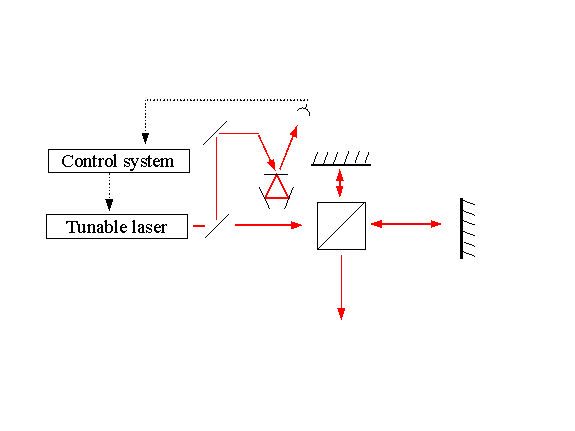Wavelength references can help reduce the wavelength fluctuations and also improve the accuracy of the average wavelength.

|
|
|
|
Wavelength References for Interferometry
|
|
|
|
|
A number of instruments used in semiconductor, photonics and MEMs fabrication facilities utilize laser interferometers for position control. An error component of the overall repeatability and positioning accuracy concerns the wavelength uncertainty of the laser, since interferometers measure in units of optical wavelength.
Interferometrically controlled precision XY stages and other interferometer-based length measurements work much better in vacuum than in air. That's because the optical wavelength of a frequency-stabilized laser fluctuates with changing air density, making measurements that are accurate to a part in ΔL/L~ 107 difficult. This research program aims to deliver better known wavelengths for higher-accuracy interferometry in air.
| The movement of air in the beam path will cause refractivity fluctuations, which (if the laser frequency is stable) means that the wavelength is fluctuating.
Often the temperature and pressure are monitored at one point in order to calculate the average wavelength. Many systems are well described by this figure on the right, which shows a large wavelength uncertainty
due to air fluctuations, and in addition an offset of the calculated average wavelength from the true average wavelength. Wavelength references can help reduce the wavelength fluctuations and also improve the accuracy of the average wavelength. |  |
A Fabry-Perot or ring cavity open to the air where the wavelength of one or more of the modes is known.What are the benefits of a wavelength reference?
Higher accuracy than meteorological measurements can provide.- Wavelength uncertainty in air as small as a few parts in 108 appears feasible.
Less noise if the index fluctuations within the reference cavity are representative of the interferometer path.
Multiple known wavelengths can be supplied, enabling absolute multiple-wavelength interferometry.
Allows tunable lasers to be used as interferometry sources.
How would a wavelength reference be used?
There are a number of ways, for instance a homodyne interferometer might be configured like this:
 | The approach is to use a laser that is wavelength-stabilized in air, instead of frequency-stabilized. This is accomplished by locking the laser to a resonance of a mechanically stable optical cavity (shown here as a triangular ring cavity). In effect the frequency of the laser is constantly adjusted so that the wavelength is constant in the air of the cavity. The cavity would be in close proximity to the interferometer beams |
Or, a heterodyne interferometer might configured using acousto-optic modulators. The laser would most likely be "optically-locked" to the reference cavity.
The wavelength reference may be calibrated by femtosecond-comb measurements. In a calibration step (with the cavity in a vacuum chamber) we measure the frequency of a test laser that is locked to a mode. Subsequently, in use in air, the reported wavelength is corrected for
Wavelength references such as these will benefit applications demanding higher accuracy positioning in air, for instance for packaging or repair tasks in the semiconductor or nanotechnology fields. Also, users demanding higher-accuracy length measurements in air will benefit, for instance in the machine-tool or optical fabrication fields.
| Here is an example of a wavelength reference. Our newer cavites are designed to be economical and facilitate mirror cleaning |
Further Reading:
Search for "wavelength references" in the NIST Time & Frequency Division publications